 |
2010 GEMINID METEOR IN ERIDANUS
Geminid Meteor Passes to Lower Left of Orion and Through Constellation of Eridanus. The conspicuous, famous constellation of Orion appears to upper left. Eridanus has only faint stars but is an ancient constellation representing a river and is sixth largest of the modern constellations. Photo taken 2010 December 13, 11:15 p.m. EST or 3h50m before Geminid in Hydra (photo below). See Larger View with Annotation and also see Movie of Geminid Meteor. Location: Looking South from Gainesville, Florida.
Photo Details: Camera Canon DSLR EOS 5D II on Fixed Tripod
Lens: Canon 20-35 f/3.5-4.5 USM at 28 mm
Exposures: 20s at f/4.0, ISO 1600
|
|
 |
2010 GEMINID METEOR IN HYDRA
Geminid Meteor in Hydra. Hydra is the largest of modern constellations and one of the longest but has only one fairly bright star (Alphard, mag. +2.0). Photo taken 2010 December 14, 03:05 a.m. EST or 3h50m after Geminid in Eridanus (photo above). Location: Looking South from Gainesville, Florida.
Photo Details: Camera Canon DSLR EOS 5D II on Fixed Tripod
Lens: Canon 20-35 f/3.5-4.5 USM at 28 mm
Exposures: 20s at f/4.0, ISO 1600
|
|
 |
2014 GEMINIDS OR NOT!
Geminid Meteors and Airplane Trails. Photos of meteors are sometimes something else. Airplane or satellite trails can be mistaken for meteors. Here are a few legitimate 2014 Geminid meteors photos along with photos of airplane trails including an ABC News photo of a trail purported to be a meteor (from an unknown photographer). But is it? Have a look and judge for yourself. Location: Gainesville, Florida. Click image to enlarge.
|
|
 |
2013 PERSEID METEOR
Perseid Meteor in Taurus. The Perseid Meteor Shower is one of the best annual meteor showers. However, dark skies are needed to see it at its best. Since this meteor shower occurs during August, many locations suffer from summer storms and humid skies sometimes making this a difficult shower to observe. This photo from the 2013 Shower was taken from a suburban location. (2013 August 12, 3:21 a.m. EDT). Location: Looking East from Gainesville, Florida.
|
|

Click picture for a larger version
or see labeled version |
2016 GREEN PERSEID METEOR
Green-Tailed Perseid Shower Meteor in Cassiopeia. This green-tailed meteor crossed through Cassiopeia on 2016 August 12, 3:56 a.m. EDT (07:56 UT). Notice how the meteor trail goes through the Perseid radiant when traced back. This shows this meteor belongs to the Perseid group and is not a sporadic meteor that is not part of the annual Perseid Meteor Shower. See labeled version. Metallic atoms and molecules can cause colored light. The green color may result from magnesium. Location: Gainesville, Florida. Camera: Canon EOS 5D Mark II on fixed tripod mount. Lens EF 20-35mm f/3.5-4.5 USM at 20.0 mm. Exposure: 30 sec at f/4.0, ISO 2000. (Image trimmed from original.) Stars slightly elongated and distorted due to length of exposure and lens aberrations. An enlargement of just the meteor appears here. See photo below for an even more colorful Perseid!
|
|

Click picture for a larger picture
or see labeled version |
2016 COLORFUL PERSEID METEOR
Rainbow Colored Perseid Meteor Takes Aim for Pleiades. This exquisitely colored Perseid meteor passes between Omicron and Zeta Perseid as it heads for the Pleiades Star Cluster on the morning of 2016 August 13 at 4:57 a.m. EDT (08:57 UT). Also see labeled version. Location: Gainesville, Florida. Camera: Canon EOS 5D Mark II on fixed tripod mount. Lens EF 50mm f/1.8 at 50.0 mm. Exposure: 20 sec at f/1.8, ISO 1250. (Image trimmed from original.) Stars slightly elongated due to length of exposure. Be sure to see this enlarged photo of the colored meteor!
|
|

Click picture for a larger version |
2020 DECEMBER GEMINID METEORS
Heading for Orion. A bright Geminid meteor streaked toward Betelgeuse in Orion shortly after midnight, 2020 December 14, 12:27:02 a.m. EST.
Frames from 11:54:35 p.m.to 1:01:08 a.m. EST (a time interval of 1h06m33s) showed seven (or 7 per hours) Geminids and some airplane trails (field abt. 84°x62°). Most were faint but the meteor heading for Orion produced a bright visual streak.
See a brief MP4 Video showing all Seven Geminids.
(or see on YouTube).
Details:
Location: Gainesville, Florida.
Camera: Canon EOS 5D Mark II on fixed tripod mount.
Lens: EF 20-135 mm f/3.5-4.5 at 20.0 mm.
Exposure: 30 sec at f/3.5, ISO 1600. (Image trimmed from original.)
Stars slightly elongated due to length of exposure.
|
|
 |
COMET PAN-STARSS C/2011 L4
Comet Pan-STARSS Over UF Hilton Convention Center. The USA has not seen a bright comet in many years. However, Comet C/2011 L4 or Pan-STARRS became barely visible to the naked eye for several days in early 2013. This was a non-periodic comet discovered June 2011 with the Panoramic Survey Telescope and Rapid Response System located near the summit of Haleakala on Maui, Hawaii.
Careful observers could spot it over Gainesville, Florida even from the west side of the University of Florida Campus. Here the comet appears over the top of the Hilton UF Convention Center on S.W. 34th Street in the evening, western twilight. Location: Looking west Over S.W. 34th Street toward UF Hilton Convention Center from behind Powell Hall and Harn Museum of Art, UF Campus, Gainesville, Florida.
Photo Details: Canon DSLR EOS 5D II, fixed mount. Canon 100-400mm, f/4.5-5.6L IS USM Lens at 400mm, Exp. 2s @ f/5.6 (ISO Equiv. 2500).
|
|

Click Photo to Enlarge |
COMET LOVEJOY C/2014 Q2
Comet Lovejoy Passes Pleiades. Comet Lovejoy barely became naked eye at end of 2014 and beginning of 2015. However, the comet developed a faint but long, contorted tail. This photo does not do the comet justice but even this combo of three photos shows the comet and its tail swinging by the Pleiades star cluster. A disk in the upper left shows the moon's apparent size (1/2 degree). Here the tail can be traced for about ten degrees. An airplane trail appears in the lower right.
Photo Details: Location: Gainesville Florida. Date/Time: 2015 Jan. 17, 8:12 to 8:20 p.m. EST. Photo Details: Canon DSLR EOS 5D II. Canon 50 mm f/1.8 at f/2.8, 3 exposures 3 min. 3 min, 2 min (ISO Equiv. 1600). Image trimmed from original frames.
|
|

Click Photo to Enlarge |
COMET NEOWISE C/2020 F3
Comet Neowise Shares the Sky with Thunderstorms. Comet Neowise became the brightest comet of the last ten years. However, naked eye visibility was limited though many great photos were made. Murky Florida summer skies often gave city and suburban observers a hard time seeing and finding this comet. Here we see Comet Neowise sharing a summer evening sky (2020 July 19) 18 degrees above the northwestern horizon, 55 minutes after sunset with thunderstorms in the distance. Photo taken from the suburban S.W. Hammock Ridge Development of Gainesville. Florida. The comet was dimly visible to the naked eye but its tail could be seen stretching across the five degree field of a 12x binocular. Estimated nuclear magnitude was +3.6.
Photo Details: Canon EOS 5D II with Canon 50 mm, f/1.8 lens at f/2.0. Exposure 15s at ISO 400. iOptron Skytracker Mount. Photo slightly trimmed after processing in Corel Paintshop Pro.
|
|
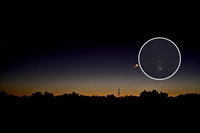
Fig. 1. 2024 Oct. 12
Barely Naked Eye
Seen in Binoculars
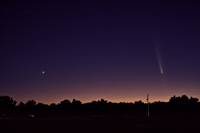
Fig. 2. 2024 Oct. 13
Easy Naked Eye
Venus on Left
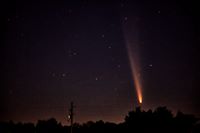
Fig. 3. 2024 Oct. 13
Close-up
With Longer Lens
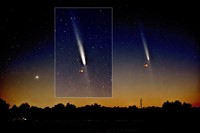
Fig. 4. 2024 Oct. 14
Shows Antitail
See Enlargement
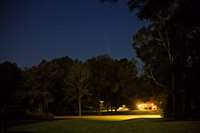
Fig. 5. 2024 Oct. 15
Still Seen From Suburbs
But Dimmer by abt. 2-1/2 mag.
|
COMET Tsuchinshan-ATLAS (C/2023 A3).
Discovered 2023 Jan. 9 at Purple Mountain (Tsuchinshan) Observatory, China and predicted to become brilliant in October 2024. Did not live up to expectations as a brilliant naked eye comet but was photographically beautiful and more easily seen with camera.
Locations: Fig. 1-4, 10 mi. SW of downtown Gainesville, Florida (Hammock Ridge).
Fig. 5, 9 mi. SW of downtown (Meadows of Kanapaha).
Photo Details: Canon EOS 5D II with Canon EF Lenses on Fixed Mount.
All times EDT (Eastern Daylight Time, 4 hrs later than UT).
Sunset about 7:00 pm EDT.
Fig. 1: Oct. 12, 7:42 pm EF50 mm f/1.8. Exp. 1/2s, f/4.5, ISO 400.
Fig. 2: Oct. 13, 8:01 pm EF50 mm f/1.8. Exp. 4s, f/4.5, ISO 1600.
Fig. 3: Oct. 13, 8:21 pm EF28-135 mm f/3.5-5.6. Exp 10s, f/5.6, ISO 2500.
Fig. 4: Oct. 14, 8:03 pm EF50 mm f/1.8. Exp. 15s, f/3.5, ISO 1250.
Fig. 5: Oct. 15, 8:26 pm EF50 mm f/1.8. Exp 2s, f/2.8, ISO 2000.
|
|
|